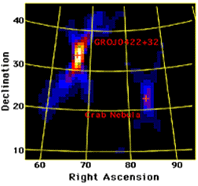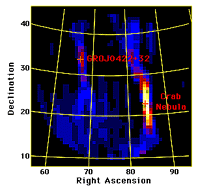Gamma-rays from Black Holes and Neutron Stars
Unlike gamma-ray emitting radio pulsars which shine on their own,
there are a large number of galactic neutron stars and black holes
which owe their gamma-ray light to the effect of a companion star.
Matter from the normal star in a binary system can be caught by
the gravitational field of the compact star. When this matter
falls onto the neutron star or black hole, a large amount of energy
is released. In fact, this process of accretion is more efficient
at releasing energy than even nuclear processes.

These are low-energy gamma-ray sources, emitting radiation up to
a few hundred keV. Generally, this emission is the high-energy
"tail" of the spectrum which is detected by X-ray experiments. Some
of these sources are the so-called
"X-ray
pulsars". The accreted matter is funneled down onto the magnetized
poles of the neutron star and we see this beam of emission as the neutron star
rotates - much like a lighthouse. Black hole sources or neutron stars whose
magnetic fields are much weaker (preventing them from focusing the matter onto
the magnetic poles) do not emit such pulsations. All of these sources,
however, are highly variable because the fuel available for accretion
can change dramatically. The flux can change many orders of magnitude,
and go from being undetectable to one of the brightest sources on the
sky.

|

|
GRO J0422+32 in outburst
|
GRO J0422+32 in quiescence
|
These two images show the variability which is characteristic
of galactic binary systems. The left-hand picture shows the Crab pulsar,
which is a source of constant flux, dwarfed by the bright outburst of a
binary system dubbed GRO J0422+32. As the outburst fades, the right-hand
picture shows the Crab again dominating the sky. Observations at optical,
X-ray, and gamma-ray wavelengths indicate that GRO J0422+32 may include a
black hole.
|
These binaries can turn off for decades, and new ones are always being
found. Gamma-ray observations help astronomers understand the basic
physics of these sources by measuring the energy and variability of
the highest energy radiation coming from these sources, radiation which
often comes directly from the central engine. Monitoring the sky for these
objects helps scientists to gain insight into how binary systems evolve.
|
